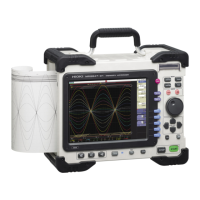13.3 Setting FFT Analysis Conditions
210
F
Select the data to be used for FFT analysis.
There are two analysis methods: analysis using new measurements and analysis of data measured
using the memory function.
13.3.2 Selecting the Data Source for Analysis
1
Select the input data source.
Move the cursor to the
[Reference] item.
2
When finished making settings, press the START key
For the [New Data] case
Measurement starts to acquire data for the number of analysis points
specified as the [Sampling Point], and FFT analysis is performed.
For the [From Memory] case
Analysis is performed on the number of specified points from data
previously recorded in memory (Memory function data) .
The analysis starting point can also be specified.
See: "13.8.1 Analyzing after Specifying an Analysis Starting Point" (
p.234)
The frequency range is selected automatically.
See: "Relationship Between Frequency Range, Resolution and Number of
Analysis Points" (
p.212)
New Data Acquire a new waveform for analysis.
From Memory
Calculates data measured using the memory function.
Procedure
To open the screen: Press the STATUS key → [Status] sheet
See: To set from the Waveform screen (
p.225)
When the input data [Reference] is
[From Memory]
Analysis is performed until the specified
number of FFT analysis points have been
processed, then the data is shifted by that
amount and analysis repeats until all of the
previously acquired data has been pro-
cessed. (If the amount of data is less than
the specified number of FFT analysis
points, no analysis occurs.)
When no trace is displayed after press-
ing the START key
Analysis is impossible if [From Memory]
is selected as the input data source and
no recorded data exists in the instrument's
memory.
Either select [New Data] as the input data
source, or load the data to be analyzed
before pressing the START key again.
1
When the [Reference] is set to [From Memory], the frequency is automatically
set.
The setting cannot be changed.

